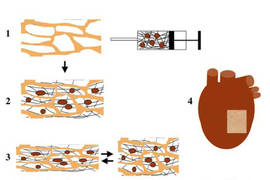Stem Cells
Classically, it was postulated that human heart did not have self-regenerative potential. This foundation radically changed in the nineties when pioneer studies demonstrated the existence of cardiomyocytes in active mitosis in the post-infarcted myocardium. However, this process was demonstrated to be clearly insufficient for the complete restoration of cardiac function post-injury. During the past 20 years, many efforts have been made to counteract this discouraging reality focusing in the exploration of novel regeneration strategies such as those based in stem cells and, more recently, tissue engineering approaches which combine application of different regenerative cell sources, biomaterials, growth factors and advanced monitoring devices has extensively been motivated. The increase in survival and retention of delivered cells within the infarcted myocardium continues been the key challenge for the development of more effective treatments against cardiac diseases.
The discovery of cardiac adipose tissue-derived progenitor cells
We focused on adipose tissue surrounding the heart as a source of adult stem cells for salvaging injured myocardium. In particular, we have worked with a population of human adult mesenchymal-like progenitors (cells that can become muscle, fat and other tissues) that our group was characterized for the first time in 2010. We have isolated and characterized these cells and found that when these cardiac stem cells were transplanted in rat and mouse models of myocardial infarction, grafted cells expressed both cardiac and endothelial markers. Moreover increased vascularization, and reduced infarct size occured . There were also differences in cardiac function, and in the thickness of the anterior wall of the heart between the control animals and those treated with these cells. Together these results suggest that the population of stem cells isolated from human adipose tissue heart could be very useful candidates for future use in cell therapy to regenerate damaged myocardium.
Therapeutic angiogenesis
The harnessing of stem cell-based therapies is hopeful for treating a variety of human injuries including cardiovascular diseases, in part, by the promotion of vascular growth and repair. Despite the acquisition of phenotypic and functional endothelial-lineage characteristics has previously been investigated using bone marrow- and adipose tissue-derived progenitors, umbilical cord blood (UCB) is currently emerging as a valuable vascular cell source. Briefly, UCB-derived mesenchymal stem cells contribute to blood vessel formation following myocardial infarction as well as may constitute a valuable in vitro model for the analysis of how vascular structures grow.

